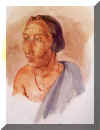A map of British Guiana showing its boundaries, prepared by the German Robert Hermann
Schomburgk, was published in 1840 and this marked the beginning of the border dispute with
Venezuela, which is still unresolved. An earlier map of British Guiana, compiled by
Captain J.E. Alexander in 1832, did not show the boundary between the countries.
In 1842, George Town became the city of Georgetown by "Royal"
warrant.
In addition to establishing the boundaries, Schomburgk's brother Richard had been
commissioned by the Prussian government to accompany Robert to collect flora and fauna
specimens in the Guiana forests for the Royal Museum and the Botanical Gardens in Berlin.
Richard contracted yellow fever upon arriving in British Guiana but survived.
He, along with the commissioned artist for the expedition W.L. Walton, were
sent back to England. Edward A. Goodall was chosen to replace Walton and would
receive a salary of 150 pounds per annum plus payment of his passage to Guiana. Upon
his return to London two years later, Schomburgk had Goodall's botanical sketches
displayed in Berlin and the Amerindian Tribes sketches in London and Paris. The
sketches aroused much interest and were eventually returned to Goodall who donated them to
the Colonial Office. From there they ended up in the British Museum
and are now in the British Library.
 Caripu
- an Atorai a now nearly extinct tribe. |
 Photo of a coloured lithograph in the B.G.
Museum by E.A. Goodall of Georgetown looking east from the lighthouse. 1841 |

Cassava bread making, Guiana
|

Interior of a Macusi house, Guiana |

Cassava bread drying on roof in Macusi village, Guiana |

Woman cooking bread, Macusi village, Guiana |
| |
|
 Photo of coloured lithograph in the B.G.
Museum. Georgetown looking south. 1841 |
 Photo of a coloured lithograph in the B.G.
Museum of Georgetown looking north east. 1841 |
|
|
|
|



